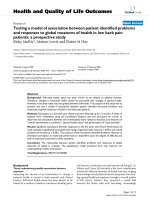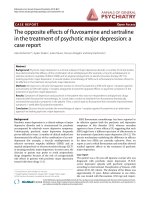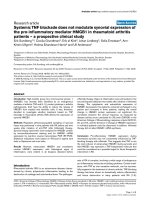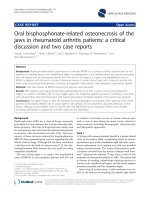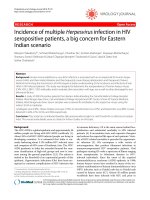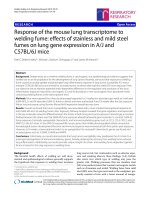Effects of acupuncture in neck pain patients a comparison of real and sham acupuncture
Bạn đang xem bản rút gọn của tài liệu. Xem và tải ngay bản đầy đủ của tài liệu tại đây (947.43 KB, 106 trang )
EFFECTS OF ACUPUNCTURE IN NECK PAIN PATIENTS:
A COMPARISON OF
REAL AND SHAM ACUPUNCTURE
DR. SHALINI GIROTRA
M.B.B.S, DIPLOMA IN ANESTHESIA (DELHI UNIVERSITY)
A THESIS SUBMITTED FOR THE DEGREE OF
MASTERS IN CLINCAL SCIENCE
DEPARTMENT OF ANESTHESIA
NATIONAL UNIVERSITY OF SINGAPORE
2004
ACKNOWLEDGEMENT
I would like to thank my supervisor Prof. Lee Tat Leang, with whose support and
guidance this project has been possible. I would also like to appreciate the staff of
acupuncture clinic for their help and understanding. My earnest thanks to NUS for taking
me as a research scholar for this project.
ii
TABLE OF CONTENTS
ACKNOWLEDGEMENTS
ii
TABLE OF COTENTS
iii
SUMMARY
ix
ABBREVIATION LIST
xii
CHAPTER 1. INTRODUCTION
1.1
Neck pain
1
1.2
Symptoms following changes in vertebrae
2
1.3
Treatment remedies available
3
1.4
Patient distribution of NUH
3
1.5
History of acupuncture
5
1.5.1
Contraindications of acupuncture
6
1.5.2
Lists of disease indicated by W.H.O
6
1.5.3
Adverse effects of acupuncture
7
Mechanism of action of acupuncture
8
1.6.1
Acupuncture physiology
8
1.6.2
Practical features of acupuncture
11
1.6.3
Modes of treatment
12
1.6.4
Myofascial trigger points
13
Effects of acupuncture on various systems
14
1.7.1
Autonomic nervous system
14
1.7.2
Peripheral blood flow
16
1.7.3
Effect of acupuncture on other organs
17
1.6
1.7
iii
1.8
Controls for study on acupuncture
17
1.9
Acupuncture trials meta-analysis
19
1.10
Thermography
21
1.11
Algometry
22
1.12
Neck pain questionnaire
23
1.13
Aims of our study
27
CHAPTER 2. MATERIALS AND METHODS
2.1
Pilot study to of acupuncture in patients with mechanical neck pain
28
2.1.1 Inclusion criteria of patients
28
2.1.2 Exclusion criteria of patients
28
2.1.3 Treatment schedule
29
2.1.4 Outcome measures
31
2.1.5 Control group
31
2.2
Comparison of needle and placebo acupuncture
31
2.2.1 Subject selection
31
2.2.2
Randomization
32
2.2.3
Outcome measures
32
2.2.4
Treatment schedule
32
2.2.5
Acupuncture technique
34
2.2.6
NPAD index
35
Materials
37
ThermaCAMTM PM 575
37
2.3
2.3.1
iv
2.3.2
Irwin OLE 1.1
39
2.3.3
AGEMATM Research 2.1
40
2.3.4
Algometer
41
2.3.5
Needles
43
Statistics
46
2.4
CHAPTER 3. RESULTS
3.1
Effect of acupuncture on blood flow in neck pain patients
48
3.2
Comparison of needle and placebo acupuncture
54
3.2.1
Comparison of the two groups at baseline level
54
3.2.2
Outcomes
55
3.2.3
VAS and NPAD score
56
3.2.4 Muscle pressure pain threshold changes
58
3.2.5 Temperature changes
62
Chapter 4.
DISCUSSION
75
CONCLUSION
80
v
LIST OF TABLES
1. Showing comparison of the neck pain specific questionnaire
25
2. Temperature at baseline and at 20 minutes at all four sessions
49
3. Comparison of the demographic data and baseline value of
two groups
54
4. Proportion of patients improved/ not improved in two groups
55
5. Muscle pain pressure threshold changes in needle and placebo group
62
6. Temperature at baseline & at 20 minutes in needle and placebo group
73
7. Comparison of the outcome in two groups
74
LISTS OF FIGURES
1. Bar chart showing patient complaints distribution at NUH acupuncture clinic.
4
2. Pain transmission
9
3. Acupuncture pathway
9
4. ThermaCAMTM PM575, infrared camera
39
5. Thermo gram with the outline drawn around it to calculate the temperature
40
6. ALGOMETER TM COMMANDER with the probe
42
7. The two probes of different sizes
42
8. Real and Sham needle
44
9. Shortening of the sham needle once it is pricked.
45
10. Park sham device with needles.
45
11. Vas score changes in patients
50
vi
12. Thermo gram before EA at 1st session
50
13. Thermo gram before EA at 10th session
50
14. Box plot showing temperature changes in control group over a period of time
with no acupuncture
51
15. Box plot temperature changes in neck pain patients at first session
51
16. Box plot temperature changes in neck pain patients at third session
52
17. Box plot temperature changes in neck pain patients at fifth session
52
18. Box plot temperature changes in neck pain patients at tenth session
53
19. Box plot showing the baseline and 20 min temperature at all the 4 sessions
53
20. Box plot showing VAS score in real and sham group of patients over
57
7 sessions
21. Box plot showing NPAD score changes in the two groups of patient
58
22. Box plot showing the pain threshold changes in real and sham group
61
23. Box plot with temperature changes over time in real group of patients
63
at first session
24. Box plot with temperature changes over time in real group of patients
64
at third session
25. Box plot with temperature changes over time in real group of patients
64
at fifth session
26. Box plot with temperature changes over time in real group of patients
65
at seventh session
27. Box plot showing temperature changes in all 4 sessions in real patients
66
28. Thermo gram 20 minutes after rest period, in the first session.
67
29. Thermo gram 20 minutes after rest period, in the third session
67
vii
30. Thermo gram 20 minutes after rest period, in the fifth session
68
31. Thermo gram 20 minutes after rest period, in the seventh session
68
32. Box plot showing temperature changes in first sessions of sham patients
69
33. Box plot showing temperature changes in third sessions of sham patients
70
34. Box plot showing temperature changes in fifth sessions of sham patients
70
35. Box plot showing temperature changes in seventh sessions of sham patients
71
36. Box plot showing temperature changes in all 4 sessions of sham patients
72
LIST OF FLOW CHART
1. Study flow chart showing comparison of needle and placebo acupuncture
36
Appendix
1.Neck pain and disability index
2.Case record form
viii
SUMMARY
The aim of this project was to see the effects of acupuncture in neck pain patients. Two
aspects were seen: first of all the effect of acupuncture on blood flow of hands, secondly
what are the differences in real and placebo acupuncture?
In the first part of the 30 patients with neck pain for more than 3 months were taken.
These patients were not having any cervical myelopathy, radiculopathy, malignancy,
diabetes mellitus or were taking any vasoactive drugs. The patients were given a course
of 10 sessions of acupuncture. During 1st, 3rd, 5th , and 10th session temperature of their
hands were taken using infrared camera. Following a resting period of 20 minutes
temperature was recorded before acupuncture (T0) was given, during the course of
acupuncture at an interval of 5 minutes (T5, T10, T15, T20, T25) and 5 minutes after
acupuncture (T30). It was seen there was an increase in temperature of the hands from the
baseline, peaking at 20 minutes. Along with this the baseline temperature at 1st, 3rd, 5th,
and 10th sessions were compared. It was seen that there was a significant rise in
temperature of the hands at 10th session in comparison to the 1st session. A control group
of 18 subjects with no neck pain was used for comparison. They were not given
acupuncture and their temperature was recorded after a resting period of 20 minutes in a
similar manner to above. In this group there was a significant decrease rather than
increase in temperature over a period of 30 minutes. Another significant feature was that
the baseline temperature of the neck pain patients was significantly lower than the normal
control subjects, which became slightly normal following a course of acupuncture.
ix
In the second part of the study, neck pain patients with similar complaints were recruited.
These were randomly allocated into real and sham group using block randomization.
Both group had 30 patients and they were very much similar to each other in the baseline
values compared. These patients were given a course of 7 sessions of real or sham
acupuncture. The outcome measures considered were: primary or subjective- VAS and
NPAD score, secondary or objective- temperature of the hand and the pain pressure
threshold. Temperatures of the hands were measured at 1st, 3rd, 5th and 7th session. Pain
threshold was measured at 1st, 5th and 7th session at four points: mid-trapezius,
infraspinatus, mid-deltoid and mid-tibia. VAS score was noted at 1st, 3rd, 5th, and 7th
session and the NPAD index was filled up at 1st and 7th session. Of the 30 patients in real
group there were only 2 patients who did not complete the course but these two were pain
free when they came for there 6th session, in total 24 patients had improved and 6 had not
improved. Whereas in the placebo group out of 30, 19 patients completed all 7 sessions,
11 patients came for 3-5 sittings. These patients did not continue, as they were not
finding any improvement in their pain status. Of the 19 patients who completed all 7
sessions 10 were relieved and 9 patients did not improve. So in total of 30 patients 10
patients improved and 20 did not get relieved. We took the best-case scenario sensitivity
analysis and considered that the patients who did not continue did not get relieved.
The VAS and NPAD score changes were significant in both groups but the change in
VAS score was more significant in the real acupuncture group. The objective measures
were different in the groups- in the real group there was a significant increase in
temperature within the session as well as in the baseline temperature and pain pressure
threshold also augmented. These changes were not seen in the placebo group.
x
Conclusion: Real acupuncture is superior to sham acupuncture in all the aspects measured
in our study. As the other group also had pain relief suggests a strong placebo subjective
effect. But this placebo effect does not bring about any objective changes.
xi
ABBREVATIONS
TCA- Traditional Chinese acupuncture
DNIC- Diffuse noxious inhibitory control
ACTH- Adrenocortical tropic hormone
MTrP- Myofascial trigger point
m-RNA- Messenger ribonucleic acid
LTR- Local twitch response
SEA- Spontaneous electrical activity
EPN- End plate noise
ReP- Referred pain
EPM- Energetic placebo model
MPM-Metameric placebo model
VAS- Visual analogue score
NPAD- Neck pain and disability index
LV- Left ventricle
BDI- Beck’s depression Inventory
EA- Electro-acupuncture
xii
INTRODUCTION
1.1 Neck Pain
Neck pain is a common complaint with a point prevalence of 10-18% and lifetime
prevalence of 30-50%. This leads to sick leave, cost of which is considerable (1,2). It is
more commonly found in women then in men, the reason being women making a larger
number of the elderly population, their smaller physical size and strength. (3)
Neck pain is caused by various reasons such as mechanical strain, whiplash injury, disc
herniation, systemic disorders etc. The most common cause is cervical spondylosis/. It
has got various synonyms as degenerative disc disease, degenerative spondylosis,
osteophytosis and spondolytic deformans. It is a vertebral ankylosis (immobility of a
joint) (4). Spondylosis is a term applied to changes noted in spine radiologically which
are significant as narrowing of disc height, presence of osteophytes arising from disc
margins, osteoarthritic changes in post zygapophyseal joints. The etiology for the
formation of osteophytes is still unknown and also whether these osteophytes are
mechanically responsible for encroachment upon neural tissue resulting neurological
symptoms. The latest theory for the formation of osteophytes is that because of the
presence of uncovertebral joints of von luschka, osteophytosis is of greater incidence in
cervical spine than in lumbar spine where these joints do not exist. As these joints are
pseudo joints – essentially exostoses- they have no cartilage intervening and being
approximating articulating osteoarthroses, they enlarge and deform from repeated
friction, compression and abrasion.
1
1.2 Symptoms following changes in the vertebraAnterior narrowed disc space and posterior longitudinal ligament thickening- This leads
to limitation of normal range of motion. This range of limited motion is not noted until
upon examination as 30-40 degree of flexion – extension and 75-90 degrees of rotation
occur at occipital level where similar changes do not occur.
Pain- pain occurs if there is superimposed trauma, acute recurrent tension, anxiety or
faulty postural changes. The osteoarthritic changes do not cause pain.
Reduction in the width and depth of intervertebral foramina along with the presence of
osteophytes- leads to nerve root entrapment symptoms as numbness, tingling, and needle
pricking sensation. Motion- extension and or rotation intensify the pressure of
osteophytes on nerve root. Faulty posture also clearly intensifies the propensity of nerve
root entrapment.
Cervical radiculopathy- sensory manifestations are more noted by the patient rather than
motor. As the sensory root lies in proximity to posterior zygapophseal joints which leads
to earlier sensory symptoms and that is why electromyography results are usually
negative. Nerve root symptoms according to the region – interscapular C5, C6; upper
extremity C5, C6; thumb C6; ring & little finger C7, C8. Commonest nerve root
involvement is at C6-C7 levels causing paraesthesia and pain radiating to radial side of
arm to fingers.
2
1.3 Treatment remedies available1. Restoration of physical posture- decrease forward head posture and decrease excessive
lordosis.
2. Supine traction with the angle, force, and duration of traction, which is determined by
the tolerance and response reaction of the patient. (5,6,7)
3. Neck brace to avoid excessive motion and provide proper posture. This should be used
for limited time period only to allow inflammation to subside but not too long which
might lead to disuse or dependence. (8)
4. Anti-inflammatory drugs or antidepressants, whenever indicated and considered to
contribute to excessive pain and to influence posture.
5. Acupuncture
6. Spinal manipulation is the use of high velocity, short amplitude thrust to move the joint
passively beyond the point at which it could be moved actively by the patient. (2)
1.4 Patient Distribution
Of all the patients who attended the National University Hospital (NUH) acupuncture
clinic in the year 2001-02 with complaint of pain, neck pain formed up to 25-30% of
patients, the rests had complaints of low back pain, migraine, headaches, knee, ankle
pain, tennis elbow, frozen shoulder etc. The following bar chart shows depictive
representation of patient distribution in NUH acupuncture clinic. (Figure1)
3
40.00
Mean %
30.00
20.00
10.00
0.00
.Back
Shoulder
Neck
Knee
Lower limb
Upper limb
Others
Head
Multiple
Area
Figure 1: Bar chart showing patient complaints distribution at NUH acupuncture clinic. (Data
collected from NUH pain clinic in 2001-02)
4
1.5 History of acupuncture
Acupuncture is a part of traditional Chinese medicine. It is believed to have originated in
China and has history in literature dated back to 200 B.C continuing till present (9-11).
Use of acupuncture in china has had its waxing and waning periods. The oldest known
text is the Yellow Emperor’s Classic of Internal Medicine. (Huang Ti Nei Ching).
Acupuncture flourished in China during the Ming dynasty. (1368-1644). It was forbidden
during the rule of Emperor Dao Guang, as he considered it as an insignificant and petty
skill. In the early part of twentieth century there was conflict in two factions of China,
one wanting to rid China of everything superstitious and unscientific, and the other not
wanting to surrender Chinese culture to western influence (12) It was reintroduced with
full force by the communist government in 1950s to cater its huge population It was
presented to Japan in 552 AD and flourished over next 200years. It arrived in Europe by
Jesuit missionaries in sixteenth century. It has been present in Northern America since
early 19th century but a great interest in acupuncture following President Nixon’s visit to
China in 1971. (13) It was given recognition by W.H.O in 1975 for specific indications
and contraindications. Since 1975, W.H.O along with China opened up international
training courses in Beijing, Shanghai and Nanjing. These training centers have trained
acupuncturist for many countries. (14) Many researches are being done to justify the
scientific use of acupuncture and not just a placebo effect.
Acupuncture is derived from Latin word ‘acu’- meaning needle and ‘puncture’ meaning
to put in. It is a loose translation of the Chinese term ‘zhen jiu’ which actually means
‘zhen’- needle (therapy) and ‘jiu’- cauterization (moxa therapy). It refers to the insertion
of dry needles at specifically chosen sites, for the treatment or prevention of symptoms
5
and conditions.
Indications include acute and chronic pain syndromes, allergic
disorders, addictions, psychosomatic and psychosexual illness and acupuncture
anesthesia and analgesia.
1.5.1 The contraindications for use of acupuncture are•
Acute bacterial infections
•
Cancer
•
Bleeding or coagulation disorders
•
Patients with pacemakers cannot receive electro-acupuncture therapy.
1.5.2 The list of 43 conditions recommended by W.H.O in 1979 are as follows (15)
•
Respiratory
Acute sinusitis, acute rhinitis, Common cold, acute tonsillitis
•
Bronchopulmonary diseases
Bronchial asthma, acute bronchitis,
•
Eye disorders
Acute conjunctivitis, Cataract, Myopia, Central retinitis
•
Disorders of mouth cavity
Toothache, Pain after tooth extraction, Gingivitis, Pharyngitis
•
Orthopedics
Per arthritis humeroscapularis, Tennis elbow, Sciatica, Low back pain,
Rheumatoid arthritis.
6
•
Gastrointestinal
Spasm of esophagus, Hiccups, Gastroptosis, Gastric hyperacidity, chronic
duodenal ulcer, Acute and chronic colitis, acute bacterial dysentery, Constipation,
Diarrhea, Paralytic ileus.
•
Neurological
Headache, Migraine, Trigeminal neuralgia, Facial paralysis, Paralysis after
apoplectic fit, Peripheral neuropathy, Paralysis by polio, Meniere’s syndrome,
Neurologic bladder syndrome, Nocturnal enuresis, Intercostals neuralgia.
1.5.3 The adverse effects of acupuncture are very few - (provided given by qualified
acupuncturists)
1. Delayed or missed diagnosis (16)
2. Deterioration of disorder under treatment (17)
3. Pain- persistent pain at the needle insertion site
4. Syncope- vasovagal attack (18)
5. Drowsiness
6. Septicemia (19)
7. Hepatitis- not prevalent these days as sterile needles are used
8. Cardiac tamponade (20)
9. Pneumothorax- this is the most frequently reported injury, either unilateral or
bilateral. (21)
7
Studies conducted by Ernst et al, pointed out that the incidence of these side effects
are negligible when compared to drug-induced complications / side effects, as drugs
are between 4th and 6th leading cause of death in U.S.A (22).
1.6 Mechanisms of action of acupuncture
Several physiological mechanisms of acupuncture have been proposed accounting for
its pain relief. Spinal and supraspinal endorphins and even activation of Diffuse
Noxious Inhibitory Control (DNIC) has also been proposed. (23) Researches have
shown that electro acupuncture of varying intensity has different changes in the mRNA expression of (pre)proopiomelanocortin, preproenkephalin and preprodynorphin
(24, 25). Other neurochemicals such as serotonin, noradrenaline and ACTH have also
been involved.
1.6.1 Acupuncture physiology has been summarized as follows:
1. Acupuncture needle inserted within the segment of pain (Spinal gate control
mechanism).
Melzack & Wall introduced the gate control theory in 1965. (26) The pain carrying
fibers are A delta II (skin), III (muscle) which are the myelinated ones; the
unmyelinated are C fibers (skin) & IV (muscle). (Figure 1)-Æ These fibers reach the
spinothalamic tract cells in the spinal tract. (2nd cell)--Æ Thalamus (3rd cell)Æ
Cortex (4th cell).
8
Fig2: Pain transmission pathway (27)
Fig 3: Acupuncture pathway (27)
Legend for Fig.2 and Fig. 3
Cell 1- Cell at painful site; Cell 2- Spinothalamic tract cell; Cell 3-Thalamus; Cell 4- Cortex;
Cell 5- Muscle afferent nerve; Cell 6- Anterolateral tract in spinal cord; Cell 7-Endorphinergic cells;
cell 8&9- Periaqeductal cell; Cell 10- Cells in the mid brain; Cell 11- Raphe nucleu; Cell 12 &13
&14-Pituitary hypothalamic complex
9
Acupuncture when applied, sends impulses to spinal cord via type II & III muscle
afferent nerves (5th cell). These are thought to signal numbness (II) and fullness (III)
sensation of de qi needling sensation. Along with this the fibers from skin via A delta
and C fibers reach anterolateral tract in the spinal cord (6th cell). From here impulses
are sent to spinal cord, mid brain and pituitary hypothalamic complex. The cell in the
spinal cord (6th cell) sends a short segmental branch to an endorphinergic cell (7th
cell) which releases enkephalin or dynorphin but not β endorphin. This endorphin
causes presynaptic inhibition of pain carrying fibers (1st cell), preventing
transmission of painful message from cell 1 to cell 2. This probably works by
reducing calcium inflow during the action potential, resulting in reduced release of
pain transmitter.
The projection from the anterolateral tract to mid brain excites cells in the
periaqeductal grey (8th & 9th cell), which release enkephalin to disinhibit the cell 10
(which is thus excited) and this in turn activates the raphe nucleus (11th cell) (located
in the caudal end of medulla oblongata). Impulses from raphe nucleus (11th cell) are
sent down to dorsolateral tract to release monoamines (serotonin and nor epinephrine)
onto the spinal cord cells. The spinal cord cell (2nd cell) is inhibited by postsynaptic
inhibition while the pain-stimulated cell (1st cell) is presynaptically inhibited via the
endorphinergic cell (7th cell). (The endorphinergic cell is excited while the spinal cord
cell is inhibited by monoamines). (Figure 2.)
2. Non- segmental effect
Cell from the anterolateral tract (6th cell) sends impulses on to the cells in the pituitary
hypothalamic complex (12th &13th cell). Cells in this complex activate raphe nucleus
10
via endorphin and cell 13 stimulates the pituitary gland to release β-endorphin. As to
how the β-endorphin from pituitary reaches the brain to cause analgesia is not known,
while it has been shown that elevated levels of β-endorphins in C.S.F and blood
accompany acupuncture analgesia. The amount in the blood is too little to cross the
blood brain barrier. Some evidence suggests that the pituitary-portal venous system
can carry hormones in a retrograde direction directly to brain. The release of pituitary
β-endorphin is correlated with an equimolar release of ACTH and MSH, as all of
them have a common precursor. Acupuncture has been found to be similar to physical
activity, stress as in these conditions also there is release of ACTH and MSH. This
complex is stimulated not at high but on only at low frequency stimulation (27).
1.6.2 Practical features of acupuncture 1. Local segmental needling usually gives a more intense analgesia than distal nonsegmental needling, as it uses the entire 3 centres (spinal cord, midbrain,
hypothalamic pituitary complex). Generally the two approaches are used together to
enhance the effect of one another.
2. Difference in the frequency and intensity of stimulation: Low frequency (2-4 Hz),
high intensity needling works through the endorphin system and activates all the 3
centres, which produces analgesia of slower onset of long duration, outlasting the 20
min stimulation session. Its effects are cumulative, become increasingly effective
after several treatments. High frequency (50-200 Hz), low intensity needling only
activates cells in the spinal cord and midbrain, bypassing the endorphin system. This
is rapid in onset, but of very short duration, with no cumulative effects.
11
The above pain relief mechanism by acupuncture has been accepted on the fact that, it
was reversed by giving naloxone (endorphin antagonist). (28, 29)
1.6.3 Modes of treatment The methods of treatment range from strict Traditional Chinese Acupuncture (TCA)
approach based on meridians with needling sensation elicited at multiple sites to an
orthodox diagnostic approach followed by superficial brief needling. The majority of
medical acupuncture practitioners trained by eastern or western schools practice
somewhere between these approaches, using a combination of trigger points, tender
points, segmental points and the most commonly used traditional points referred to as
‘strong’ points.
Other acupuncture techniques in common use in the west is electro- acupuncture and
use of semi permanent indwelling needles.
Western-based acupuncture treatment is used in the following conditions1. Painful conditions: Myofascial pain- trigger points approach to treatment
2. Non-myofascial pain: nociceptive pain and visceral pain- best approached with
segmental acupuncture
3.Neurogenic pain- where direct segmental stimulation may be effective or may
exacerbate symptoms, in which case an extra segmental approach may be used.
4. Acute or post-surgical pain.
5. Non-painful conditions-commonly treated with a local or segmental approach or
for generalized conditions a selection of well known traditional points.
12
1.6.4 Myofascial trigger points (MTrP) A myofascial trigger point as defined by Travell and Simons (30) is a hyper irritable
focus within a taut band of skeletal muscle or its associated fascia. The trigger point is
painful on compression and can exhibit a characteristic referral pattern of pain or
autonomic dysfunction and may also exhibit a jump sign and twitch response.
In our study we used pressure algometer as an objective mean to identify the muscle pain
threshold of some predetermined muscle points before and after treatment.
Neurophysiological evidence of tender point Hubbard and Berkoff demonstrated that myofascial tender point showed increased
electrical activity within an area of 1 or 2mm around the tender point relative to a normal
area of same muscle. (31) Such similar results were also shown by Ward (32), who
demonstrated spontaneous electrical activity in tender points at 2 locations that were also
acupuncture points. Further studies showed that a physiological stressor significantly
increased the electrical activity of trapezius tender point compared to a non-stressful
control task. (33,34)
There are multiple MTrP loci in an MTrP region. An MTrP locus contains a sensory
component (sensitive locus) and a motor component (active locus). A sensitive locus is
the site from which pain, referred pain (ReP), and local twitch response (LTR) can be
elicited by needle stimulation. Sensitive loci are probably sensitized nociceptors based on
a histological study. They are widely distributed in the whole muscle, but are
concentrated in the endplate zone. An active locus is the site from which spontaneous
electrical activity (SEA) can be recorded. Active loci are dysfunctional endplates since
13

![Báo cáo khoa học: Epoxidation of benzo[a]pyrene-7,8-dihydrodiol by human CYP1A1 in reconstituted membranes Effects of charge and nonbilayer phase propensity of the membrane pot](https://media.store123doc.com/images/document/14/rc/ld/medium_ldo1394248806.jpg)

